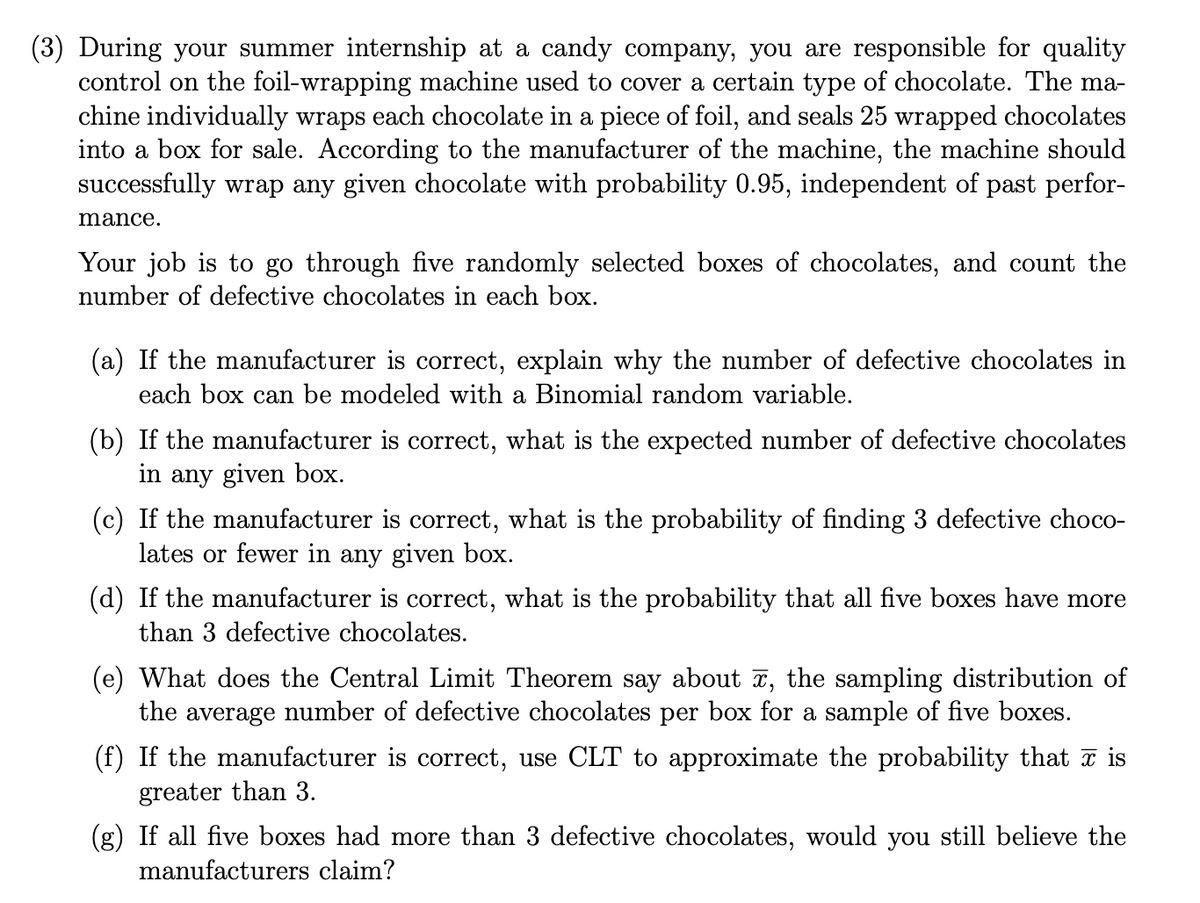(3) During your summer internship at a candy company, you are responsible for quality control on the foil-wrapping machine used to cover a certain type of chocolate. The ma- chine individually wraps each chocolate in a piece of foil, and seals 25 wrapped chocolates into a box for sale. According to the manufacturer of the machine, the machine should successfully wrap any given chocolate with probability 0.95, independent of past perfor- mance. Your job is to go through five randomly selected boxes of chocolates, and count the number of defective chocolates in each box.
(3) During your summer internship at a candy company, you are responsible for quality control on the foil-wrapping machine used to cover a certain type of chocolate. The ma- chine individually wraps each chocolate in a piece of foil, and seals 25 wrapped chocolates into a box for sale. According to the manufacturer of the machine, the machine should successfully wrap any given chocolate with probability 0.95, independent of past perfor- mance. Your job is to go through five randomly selected boxes of chocolates, and count the number of defective chocolates in each box.
Holt Mcdougal Larson Pre-algebra: Student Edition 2012
1st Edition
ISBN:9780547587776
Author:HOLT MCDOUGAL
Publisher:HOLT MCDOUGAL
Chapter11: Data Analysis And Probability
Section11.8: Probabilities Of Disjoint And Overlapping Events
Problem 2C
Related questions
Question
3)

Transcribed Image Text:(3) During your summer internship at a candy company, you are responsible for quality
control on the foil-wrapping machine used to cover a certain type of chocolate. The ma-
chine individually wraps each chocolate in a piece of foil, and seals 25 wrapped chocolates
into a box for sale. According to the manufacturer of the machine, the machine should
successfully wrap any given chocolate with probability 0.95, independent of past perfor-
mance.
Your job is to go through five randomly selected boxes of chocolates, and count the
number of defective chocolates in each box.
(a) If the manufacturer is correct, explain why the number of defective chocolates in
each box can be modeled with a Binomial random variable.
(b) If the manufacturer is correct, what is the expected number of defective chocolates
in any given box.
(c) If the manufacturer is correct, what is the probability of finding 3 defective choco-
lates or fewer in any given box.
(d) If the manufacturer is correct, what is the probability that all five boxes have more
than 3 defective chocolates.
(e) What does the Central Limit Theorem say about 7, the sampling distribution of
the average number of defective chocolates per box for a sample of five boxes.
(f) If the manufacturer is correct, use CLT to approximate the probability that a is
greater than 3.
(g) If all five boxes had more than 3 defective chocolates, would you still believe the
manufacturers claim?
Expert Solution
This question has been solved!
Explore an expertly crafted, step-by-step solution for a thorough understanding of key concepts.
Step by step
Solved in 3 steps

Recommended textbooks for you

Holt Mcdougal Larson Pre-algebra: Student Edition…
Algebra
ISBN:
9780547587776
Author:
HOLT MCDOUGAL
Publisher:
HOLT MCDOUGAL


Holt Mcdougal Larson Pre-algebra: Student Edition…
Algebra
ISBN:
9780547587776
Author:
HOLT MCDOUGAL
Publisher:
HOLT MCDOUGAL
